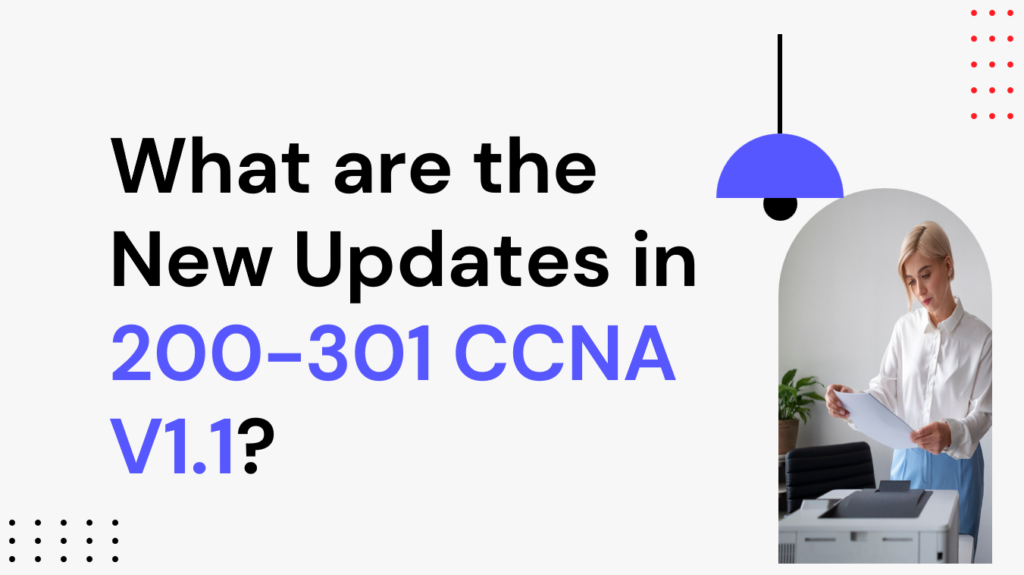What are the New Updates in 200-301 CCNA V1.1?
Category:
Comments:
Post Date:
The 200-301 CCNA exam has recently undergone an update to version 1.1. The update brings new topics into the mix, reflecting the industry's shift towards emerging technologies like Generative AI, Cloud Network Management, and Machine Learning. Although these new topics account for less than 10% of the total exam content, they are critical areas that networking professionals need to be familiar with.

Generative AI
Generative AI, which refers to AI systems capable of generating content, such as text, images, and even network configurations, has been making waves across various industries. In the context of networking, Generative AI can be used to automate complex network tasks, enhance security by predicting potential threats, and optimize network performance by generating optimal configurations. The inclusion of this topic in the CCNA V1.1 exam highlights the growing importance of AI in modern network management.
Key Concepts to Study:
- Understanding how Generative AI can be applied in networking.
- Use cases of Generative AI in network automation and security.
- Basic principles of AI and machine learning as they relate to networking.
Cloud Network Management
As organizations increasingly adopt cloud technologies, the need for skilled professionals who can manage cloud-based networks is rising. Cloud Network Management focuses on the tools and techniques used to manage, monitor, and secure networks that span on-premises and cloud environments. The CCNA V1.1 exam now includes this topic to ensure that candidates are well-versed in managing hybrid networks.
Key Concepts to Study:
- Fundamentals of cloud networking and cloud service models (IaaS, PaaS, SaaS).
- Tools and platforms for cloud network management (e.g., Cisco Meraki, AWS VPC).
- Challenges and best practices for securing and managing cloud-based networks.
Machine Learning
Machine Learning (ML) is another cutting-edge technology that has been integrated into the CCNA V1.1 exam. ML involves using algorithms and statistical models to analyze and draw inferences from patterns in data. In networking, ML can be used to predict network traffic patterns, identify potential security breaches, and automate network management tasks. The inclusion of ML in the exam underscores the importance of data-driven decision-making in modern network management.
Key Concepts to Study:
- Basics of machine learning and its application in networking.
- How ML can be used to enhance network security and performance.
- Examples of machine learning algorithms used in networking (e.g., anomaly detection).
Impact on Exam Preparation
While the introduction of these new topics might seem daunting, it's important to note that they make up less than 10% of the total exam content. The core of the CCNA exam still revolves around fundamental networking concepts like IP addressing, routing and switching, and network security. However, candidates should allocate some study time to familiarize themselves with these emerging technologies.
Study Tips:
- Incorporate online resources, such as Cisco's official study materials and labs, to get hands-on experience with cloud network management tools.
- Explore introductory courses or tutorials on Generative AI and Machine Learning to grasp the basics.
- Stay updated with the latest trends in networking to understand how these new topics are being applied in real-world scenarios.
The updates in the 200-301 CCNA V1.1 exam reflect the rapid advancements in networking technology. By including topics like Generative AI, Cloud Network Management, and Machine Learning, the exam ensures that certified professionals are equipped with the knowledge needed to navigate the complexities of modern networks. While these topics are a small part of the overall exam, they represent significant areas of growth in the field of networking. Candidates preparing for the CCNA V1.1 exam should approach these new topics with curiosity and a willingness to learn, as they are likely to play an increasingly important role in the future of networking.
TAGS:
